Your fur child is scratching their ears more than usual – sometimes to the point, they are crying out from scratching too hard.
Maybe they’re waking you up in the middle of the night, shaking their heads repeatedly.
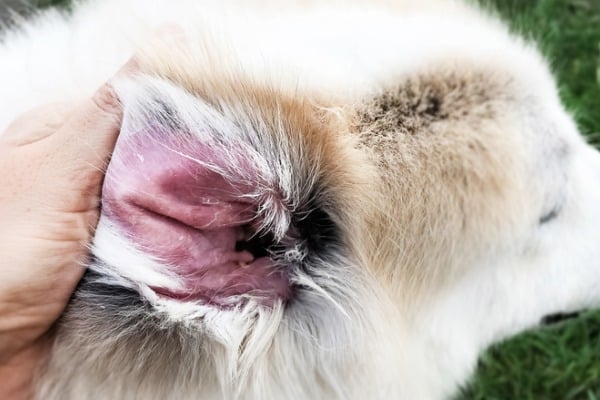
You know something is up, so what causes a dog to scratch their ears incessantly?
Dogs have fantastic hearing, but that doesn’t mean they have tough ears.
In fact, they commonly develop infections and suffer from other ear-related ailments.
It could be a variety of issues:
Several common culprits might be making your pup miserable and itchy.
Wax build-up, allergies, mites, or yeast overgrowth could be to blame.
Sometimes it takes the wisdom of the vet to diagnose the issue, but there are some signs you can look out for to help figure out what’s bothering your dog.
The good news?
We’ll delve into how to tell the difference between ear mites and yeast infections, how you can help your dog, and when you should let a vet take over.
Contact a Vet
Alternatively, you can have a quick chat with a vet online now, which is both a cost and time savings.
Connect with a verified veterinarian in minutes. No waiting for appointments or office hours. No high fees. Your pet's health made convenient and worry-free.
The Dirt on Ear Mites
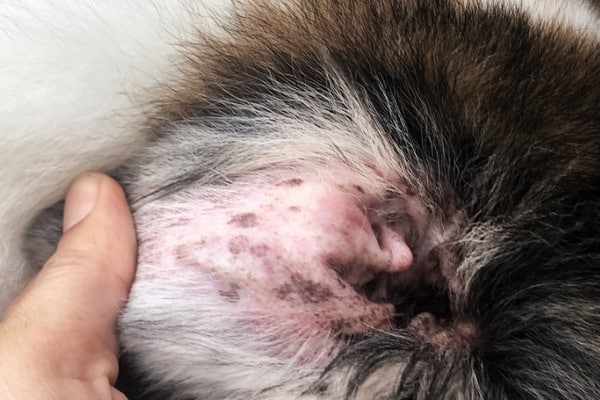
You can think of ear mites as the lice of the canine world.
Don’t panic; they very rarely infest humans – we don’t have any environment on our bodies that is attractive to them.
They are, however, contagious to other four-legged family members, like cats and rabbits.
Otodectes Cynotis is the scientific name for these unwelcome visitors.
The crazy part?
They spread like wildfire – one female mite landing on your dog has the potential to spark a full-blown infestation.
They’re a little difficult to prevent other than controlling access to other infected animals.
Your dog’s monthly parasite preventive medication is effective at keeping out intestinal worms but not ear mites.
The flea and tick prevention you apply to your dog’s skin can help keep ear mites away, but it’s not foolproof.
Dogs often pick up ear mites in daycare, at the vet’s office, or in boarding facilities.
If your dog gets infected with them, it’s very likely they have spread to other mammalian pets in the household.
Identifying Ear Mites
Diagnosing this problem at home is possible if you have a magnifying glass.
You’ll probably notice your dog digging at their ears or rubbing their heads on everything it can reach, tipping you off to a potential ear issue.
While mites are visible under a magnifying glass, you won’t see much but movement unless you have a strong one.
Instead, you’ll see small, white dots that move around your dog’s ear.
You might also notice the inside of your dog’s ear is scabby and has a foul smell.
Did you know that cats also can have ear mites?
Treating Ear Mites
The first thing you should do is quarantine your dog.
It sounds extreme, but even at the dog park or pet store, ear mites can spread to other animals.
Don’t be that person who brings a dog with ear mites to socialize with other dogs until the infestation has cleared.
It’s best to let the vet handle this issue.
Even if you don’t see ear mites in your dog’s ear, it doesn’t mean they don’t have them – and seeing them doesn’t mean there isn’t a secondary issue at work.
The otoscope your vet uses to look into your dog’s ear provides a much better view of what exactly is going on.
Why get it confirmed by the vet if you see ear mites yourself?
This issue isn’t one you should try to treat on your own.
Dogs can scratch their ears so vigorously that they can damage their ear canal and eardrums.
The parasites themselves can grow out of control, and in severe cases, it can cost your dog their hearing.
Don’t hesitate to see the vet:
It’s not something you want to waste time on DIY treatments that might not work.
Many OTC treatments work to kill the living mites but not the eggs, so the problem will seem to be solved until the eggs hatch, and the cycle begins again.
In the meantime, your dog will be itchy and uncomfortable.
Your vet might look at your dog’s ears and determine that an OTC treatment is sufficient to cure the issue.
What’s more…
It could also have progressed to the point where your dog needs antibiotics and heavy-duty treatment, which is only available with a prescription.
Only the vet can know for sure which course of treatment is best.
Either way, whatever your vet prescribes will take the guesswork out of the treatment process and give your dog relief as soon as possible.
You’ll need to wash bedding and clean up dog hair around the house since ear mites can live on shed hairs and reinfest your dog.
All bedding your dog has come into contact with should be washed in hot water and ideally put in the dryer at a high temperature.
Thorough vacuuming of pet hair will be necessary, as well.
Dispose of your vacuum bag or empty the canister somewhere outside – mites can survive the vacuum and crawl out of the garbage can.
Even if other animals in the house aren’t showing signs of ear mites, they should be treated as well due to the highly contagious nature of this organism.
Dog Yeast Infections
Ever notice a corn chip-Esque smell coming from your dog’s feet?
That’s a normal and natural smell many pet parents notice, and it’s not caused by anything harmful.
Multiply that smell by about ten and maybe add a foul top note to the scent.
If you get a whiff of something like that coming from your dog’s ears, it’s a red flag that they have a yeast infection.
The yeasty smell can be akin to bread dough, chips, or cheese – or dog ear yeast can be downright stinky.
Yeast infections in dogs can occur anywhere on the skin, but the ears are the more common location for it to occur.
How else can you know if your dog has a yeast infection in their ear?
Like in the case of ear mites, you will probably notice your dog scratching their ears before you see other symptoms.
Dogs will dig at their ears with their back foot. Sometimes they will then sniff their feet afterward.
Shaking their heads the same way they shake off water is another way dogs try to relieve itchy ears.
The difference is they can do this repeatedly in an attempt to scratch the itch.
If your dog wears a collar with tags, you know how noisy the head-flopping can be – it’s enough to wake most pet parents from a deep sleep.
Your dog’s ears might feel hot to the touch, and also tender. They might cry if you try to touch their ears.
More signs?
There can also be discharge or scabs in the ear, which can be from excessive scratching or a secondary infection.
Yeast infections can occur alongside bacterial infections, and the signs are similar.
In severe infections, a dog’s balance and hearing may be affected.
You might notice your dog running into things, unable to walk a straight line, or tilting their head to hear better.
Why Did My Dog Get a Yeast Infection?

Warm weather and excess moisture are two major causes of yeast infection.
A swim in the local lake or a bath can trigger the infection.
The breed of your dog could also make them more susceptible.
Dogs with “floppy” ears – ears that don’t stand erect – have a higher risk of developing a yeast infection of the ear.
Having their ear more closed off makes an ideal environment for yeast to grow into an infection.
Another thing…
Extra hair in the ear can also be an inviting place for yeast to grow.
Fluffy dogs with poofy ear hair can be prone to yeast infections, whether their ears are erect or not.
Dogs with allergies and sensitivities to food, grass, and other environmental factors are more likely to develop a yeast infection of the ear.
If your dog has recently had a course of antibiotics, it could have caused the overgrowth of yeast or infection.
Treatment
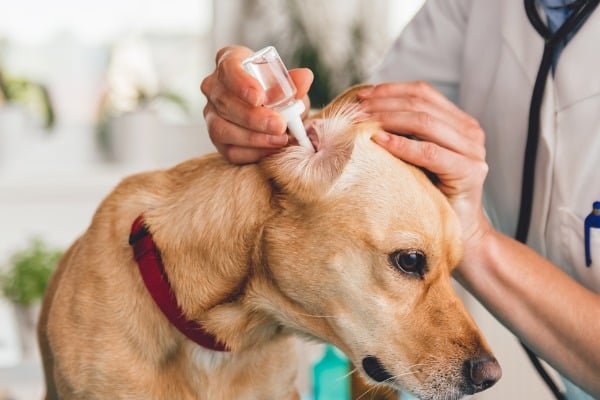
It’s crucial for your vet to diagnose yeast infections since they frequently come with other bacterial infections.
Treating at home with an antifungal can help the yeast end of things, but it won’t clear up bacterial infections.
Trust us:
A vet will take a culture from inside your dog’s ear to see precisely what you’re dealing with.
They can recommend OTC treatments like miconazole in simple infections that affect only the outer ear.
In more complicated infection that has migrated deeper into the ear, a topical antifungal won’t help.
In this case, your vet will offer injections or oral medications to clear up the infection.
The case for letting the vet handle it is a strong one – like in-ear mite infections; the complications can cause hearing loss and permanent damage to the ear canal.
Letting a vet diagnose the type and severity of the infection is best.
If you’re wondering how to treat an ear infection without a vet, the answer is you shouldn’t – unless you’re willing to gamble with your dog’s hearing and overall well-being.
Leave the DIY for preventive habits.
Prevention
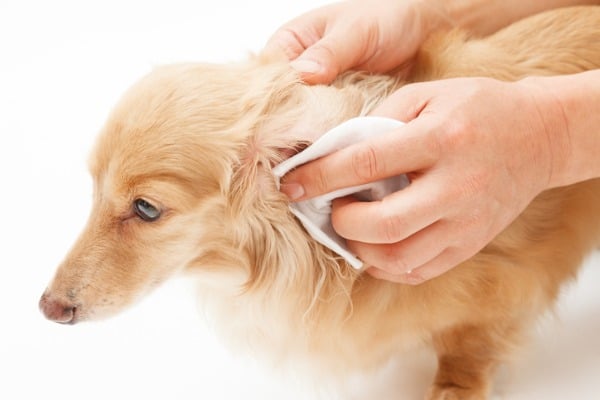
Now, onto some good news about yeast infections.
There are several measures to negate the risk of your dog developing one.
One of the best things you can do for your dog is to keep your dog’s ears dry.
After swims, baths, and romps through the sprinkler, take the time to blot your dog’s ears of any extra moisture.
You don’t have to go digging around with a q-tip – a couple of cotton balls or an old towel is plenty to soak up excess water and dry your dog’s ears.
We don’t recommend putting a blow dryer directly on your dog’s ears.
The sound can upset and spook them – remember, they have sensitive hearing.
The heat of the blow-dryer can also burn them.
If you feel it necessary to blow-dry your dog’s ears, use only dryers that offer a heat-free setting.
Keep the airflow on low, and don’t hold it directly to your dog’s ear – keep it at least six inches from their head.
Regular ear cleaning is something you can do at home, provided your dog cooperates. It doesn’t require vet school to do it, only a gentle hand.
Cleaning is especially critical if you live in a hot, humid environment. In this type of climate, dogs can require more frequent cleanings.
If your dog has particularly hairy ears, you can cut down the risk of infection by having a groomer clip the insides.
This is something else you can do yourself if you’re experienced and comfortable with doing it.
Probiotics can be helpful in preventing yeast infections and have a plethora of other benefits for your dog.
Your vet might suggest this as a preventive measure if your dog has recurring yeast infections.
Mites, Yeast, or Something Else?
The variety of causes for your dog’s symptoms is why we recommend getting a vet’s opinion.
Dogs who itch their ears or display general discomfort in the ear can have bacterial infections, allergies, or simply wax build-ups.
Dog Ear Mites Vs. Ear Infection
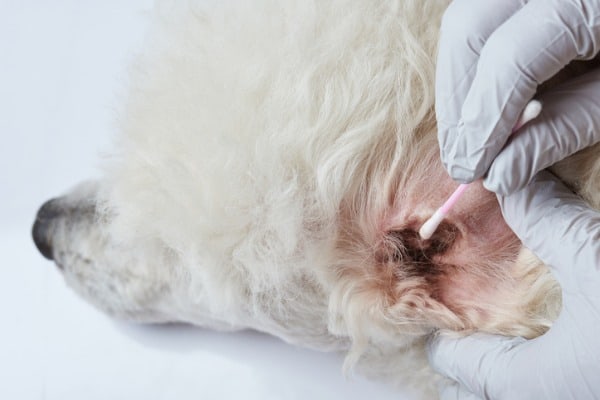
The symptoms of each issue can be virtually indiscernible to the untrained eye.
Seeing the mites is the only way you can know they have them, which doesn’t rule out a secondary infection.
Dogs with ear infections, or otitis interna, can display ear discharge, which can be brown, bloody, or yellow. It will also likely have a foul odor.
Their ears might also feel warmer than usual, or they may not allow you to touch their ears at all due to pain and tenderness.
The inner ear can also appear swollen and red.
If you’re asking, “does my dog have ear mites or an infection,” you’ll get the most accurate answer from a vet.
Why is it so important to diagnose the issue properly?
In severe infections, the facial nerve can be affected. Your dog might have trouble blinking, drool excessively, have trouble eating, and have droopy eyes.
Mites and infections are two separate problems that require different treatments.
Bacterial infections require vet-prescribed antibiotics to treat.
Dog Ear Wax Vs. Ear Mites
A build-up of earwax will often manifest itself in discharge, which is your dog’s body trying to clear up excess wax.
Since the discharge is a less common symptom of ear mites, it usually indicates a build-up of wax or infection.
It’s entirely possible your dog has wax build-up without mites.
Some breeds – like poodles, cocker spaniels, and bulldogs – are more likely to suffer from ear wax issues.
Lack of regular cleaning can also cause the wax to build up.
Both mites and excessive wax can cause similar itchiness and discomfort for your dog.
Excess wax can also be a side-effect of a mite infestation.
The only way to rule out mites entirely is to let the vet diagnose the issue.
Protect the Dear Ears
Mites, yeast, bacteria – oh my.
You might not have realized the range of issues that can befall your best friend’s ears.
You also might not think of it as a serious health problem since it’s not affecting any vital organs.
Indeed, ear infections and complications rarely threaten your pet’s life.
Keeping those fuzzy ears clean and healthy is still vital, however.
Fortunately, dog-ear yeast, mites, and other infections are easy to treat once diagnosed.
These types of issues are not usually ones to break the bank or put a serious cramp in you and your dog’s lifestyle – as long as they’re not allowed to progress into bigger problems.
Let the vet do their job:
It’ll save you stress, time, and money in the long run.
Your furry family member will also be spared pain and discomfort.
Remember that sometimes, dogs just need to scratch their ears. Unless you notice other symptoms, that itch could simply be an itch.

